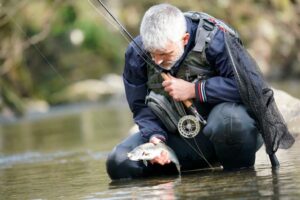Freshwater fish list in Grand Duchy of Luxembourg

Nestled in the heart of Europe, Luxembourg boasts an array of pristine rivers, lakes, and ponds that provide a rich habitat for a diverse range of fish. This article will take you through the list of freshwater fish in Luxembourg, highlighting the unique species that call these waters home.
From the iconic Pike and Perch to the graceful Trout and Carp, we will explore each fish’s characteristics, habitats, and angling opportunities. Whether you are a seasoned angler looking to expand your knowledge or a curious enthusiast eager to learn more about the local fish species, this article is your gateway to discovering the remarkable freshwater fish diversity in the Grand Duchy of Luxembourg.

Game fish list in Grand Duchy of Luxembourg
Game fish are highly sought after by anglers due to their sporting qualities and appeal as a recreational catch. In the Grand Duchy of Luxembourg, the Brown Trout (Salmo trutta fario) is a prized game fish known for its beauty and elusive nature. Brown trout are found in pristine rivers and streams, allowing anglers to test their skills in clear waters, presenting a rewarding challenge. Anglers in Luxembourg can experience the excitement and thrill of pursuing these game fish, creating memorable fishing experiences in the country’s breathtaking natural surroundings.
Game fish list in Grand Duchy of Luxembourg
- Northern Pike (Esox lucius)
- Brown Trout (Salmo trutta fario)
- European Chub (Squalius cephalus)
- European Wels Catfish (Silurus glanis)
- Grayling (Thymallus thymallus)
Panfish list in Grand Duchy of Luxembourg
Panfish refers to a group of fish species that are typically smaller and often targeted by anglers for their abundance and suitability for various fishing methods. In Luxembourg, several fascinating panfish species can be found in the freshwater bodies. The first is the Roach (Rutilus rutilus), a popular panfish known for its silvery appearance and schooling behaviour. Roach are often targeted using light tackle and are a delight for anglers who enjoy finesse fishing techniques. Another common panfish is the Eurasian Rudd (Scardinius erythrophthalmus), recognised for its vibrant golden colouration and distinctive upturned mouth. Rudd can provide excellent sport and is known for their willingness to take various baits and lures. The Bleak (Alburnus alburnus) is a small panfish species known for its slender body and high abundance. Often found in large schools, bleak provides a fun fishing experience for anglers of all skill levels. Gudgeon (Gobio gobio) and Minnow (Phoxinus phoxinus) are panfish species commonly encountered in Luxembourg. These small but aggressive fish allow anglers to enjoy light tackle angling and are particularly popular among beginners and young anglers. Luxembourg’s freshwater bodies are home to a diverse range of panfish, providing ample opportunities for anglers to engage in enjoyable and rewarding fishing experiences.
Panfish list in Grand Duchy of Luxembourg
- Roach (Rutilus rutilus)
- Eurasian Rudd (Scardinius erythrophthalmus)
- European Bitterling (Rhodeus amarus)
- European Bleak (Alburnus alburnus)
- Gudgeon (Gobio gobio)
- Minnow (Phoxinus phoxinus)
- Dace (Leuciscus leuciscus)
Bottom feeder list in Grand Duchy of Luxembourg
Bottom feeders are a group of fish species that have adapted to feed primarily on or near the bottom of water bodies. In Luxembourg, several intriguing Bottom feeder species are found in the freshwater habitats.
One such species is the European Eel (Anguilla anguilla), known for its snake-like appearance and migratory behaviour. Eels are skilled bottom foragers, using their keen sense of smell to locate food hidden in the substrate. Another standard bottom feeder is the Prussian Carp (Carassius carassius), a hardy fish species with a preference for feeding on the bottom or grazing on aquatic vegetation.
The Stone Loach (Barbatula barbatula), European Bullhead (Cottus perifretum), Spined Loach (Cobitis taenia), and Weather Loach (Misgurnus fossilis) are also bottom feeder species found in Luxembourg. These fish have specialised adaptations for feeding on insects, worms, and other tiny organisms that dwell in or around the substrate. Bottom feeders play an essential role in the aquatic ecosystem by helping to clean up organic matter and maintaining a balanced food chain. Anglers in Luxembourg may encounter these intriguing bottom feeders while pursuing their fishing adventures, adding diversity and excitement to their angling experiences.
Bottom feeder list in Grand Duchy of Luxembourg
- Common Carp (Cyprinus carpio)
- Crucian Carp (Carassius carassius)
- European Barbel (Barbus barbus)
- Common Bullhead (Cottus perifretum)
- European Eel (Anguilla anguilla)
- Freshwater Bream (Abramis brama)
- Common Nase (Chondrostoma nasus)
- Rhineland Sculpin (Cottus rhenanus)
- European Bullhead (Cottus gobio)
- Spined Loach (Cobitis taenia)
- Stone Loach (Barbatula barbatula)
- Tench (Tinca tinca)
- Weather Loach (Misgurnus fossilis)
- White bream (Blicca bjoerkna)
Predatory fish list in Grand Duchy of Luxembourg
Predatory fish are a species known for their predatory behaviour and feeding habits. These fish have specialized anatomical features, such as sharp teeth, streamlined bodies, and keen senses, that allow them to hunt and capture their prey effectively. In Luxembourg, several remarkable predatory fish species can be found in the freshwater environments. An impressive predator is the European Catfish (Silurus glanis), known for its enormous size and voracious appetite. Catfish are opportunistic hunters who can prey on various fish and small mammals.
These predatory fish species play a crucial role in maintaining the ecosystem’s balance by regulating smaller fish populations and contributing to the natural order of the food chain. Anglers in Luxembourg can pursue the thrill of catching these predatory fish, which offer exciting angling opportunities and memorable encounters with some of nature’s most skilled hunters.
Predatory fish list in Grand Duchy of Luxembourg
- Northern Pike (Esox lucius)
- European Perch (Perca fluviatilis)
- European Wels Catfish (Silurus glanis)






